| |
|
Of
mites, nematodes and fungi ...
all living
together
by M. Halit Umar
|
This
is the third of a series of articles by the author
with the theme that
'life is a continuous interaction between organisms'.
(Read part one and two.)
When
sitting to write this essay, I suddenly remembered the famous
book by John Steinbeck, Of mice and
men. At first
glance, a story of an unnatural and
rare kind of relationship, between men and
mice... But how unusual is such a
relationship? Was I not thinking and
writing in the same sense 'of
mites, nematodes and fungi?'
As
a rule, it is not possible to conceive of life
in our biosphere without interdependence. With
this in mind I've replaced 'mice and men' with
other living organisms to create my new tale.
*
Of
mites ...
Pygmephorus sellnicki, the so-called red
pepper mite, lives on the growing and mature
fruit bodies of the cultivated white button
mushroom, Agaricus
bisporus. Pygmephori are small organisms
(ca. 0.1 to 0.2 mm long) but can easily be
observed with a magnifying glass or a
stereomicroscope. Pygmephorus
sellnicki is generally harmless to
the host mushroom but its presence indicates the
co-existence of other, frequently pathogenic,
organisms like Trichoderma
spp. Once the phenomenon of parasitism
starts, other pathogens and/or less harmful
parasites, nematodes for example, may easily
flourish in due course.
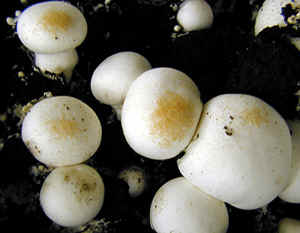
Red pepper mite (Pygmephorus
sellnicki) infestation on
the growing, young fruit bodies of Agaricus
bisporus. Note the readily
visible, yellow-brown to reddish tinted
areas on the caps which correspond to the
agglomeration of hundreds of parasites.
They are very loosely attached, so they
easily fall off and spread if the fruit
bodies are picked up. Air currents may
also cause their dissemination. The mites
can provoke skin
irritation, itching and
transitory allergic reactions .
|
~~~~
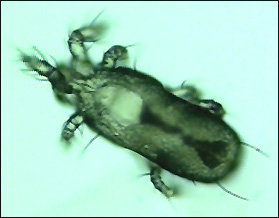 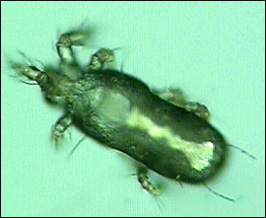
Pygmephorus
sellnicki. Two LM
images of the same mite. The second
image was obtained using slight
polarization. Dorsal view.
~~~~
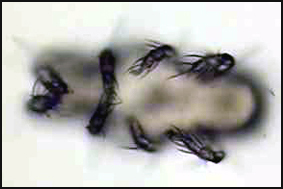
Pygmephorus
sellnicki,
ventral view.
~~~~
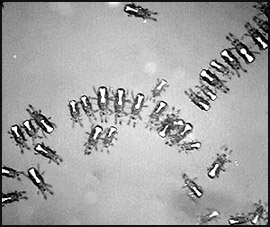 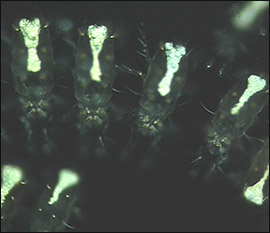
Pygmephori
sellnicki collected on a
wet glass slide. First image: low
magnification and slight polarization.
Second image: high magnification and
complete polarization.
~~~~
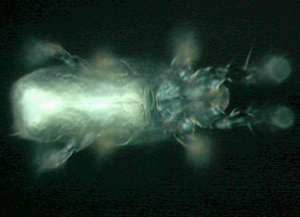
Pygmephorus
sellnicki.
Cover slip applied. LM,
polarized light; oil
immersion objective, 100x.
~~~~
nematodes ...
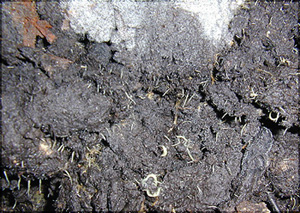
During red pepper
mite infestation of the mushroom,
the mass of nematodes
can be seen as a waving
structures on the soil.
The closely packed nematodes are
shown below:
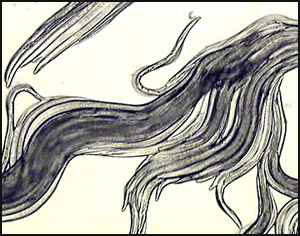
~~~~
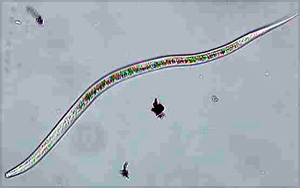
LM image, slightly
polarized light. The nematode is an
elongated organism with one end
(lower left) blunter than the other.
Nematodes possess a
limited number of cells and show a relatively
simple anatomy. This is why the
nematode Caenorhabditis elegans
became a preferred model organism
among several others for molecular
biological investigations.
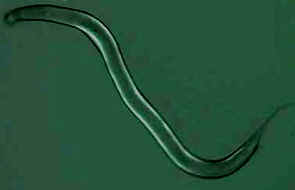
LM image, using almost
completely polarized light. Note that
the cuticle of the nematode is
birefringent, observed as a bright
surface structure.
~~~~
and fungi ...
The white
button mushroom Agaricus
bisporus
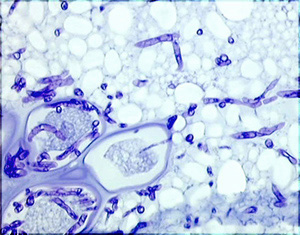
Hyphae
of Agaricus
bisporus (dark
blue stained, tubular
structures) feeding on and
growing towards the central
part of a wheat grain.
Inoculated grains prepared
under sterile conditions are called spawn
and used to
cultivate mushrooms.
|
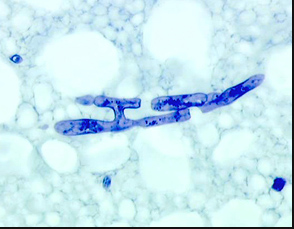
A
detailed view of the hyphae
of Agaricus
bisporus
growing inside the grain. The
'foamy' background is
the starchy endosperm.
|
~~~~
The microscopic fungus
Arthrobotrys
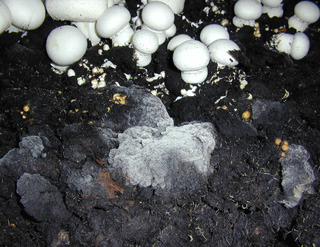
On the same
cultivation bed for the mushrooms; as
well as a mite infestation and
swarming nematodes, there is another
organism namely a microscopic fungus
called Arthrobotrys.
The presence of this heavily
spore-forming microscopic fungus is
visible as light blue to gray patches
on the soil surface. This fungus usually
feeds on trapped nematodes.
|
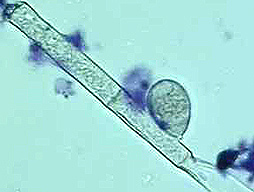
A hypha
and a newly formed spore of
Arthrobotrys oligospora
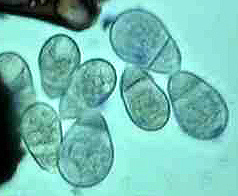
Spores
of Arthrobotrys are
usually pear-shaped and show a cross septum
dividing the spore into two distinct areas.
|
~~~~
Some
nematodes feed on mycelium, hence the name myceliophagous
nematodes. Other nematodes feed on
bacteria. Soil is a rich and diverse source of
uni- and multicellular organisms in various
stages of their life cycle which continuously
compete for survival.
The
defense mechanisms of the cultivated mushroom's
fruit bodies steadily become exhausted when they
are attacked by mites, nematodes and pathogenic
fungi like Trichoderma
spp. and bacteria like Pseudomonas
spp. Such severely
parasitized mushrooms
will eventually disintegrate.
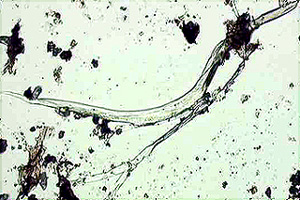
Arthrobotrys
oligospora trapping a nematode.
~~~~
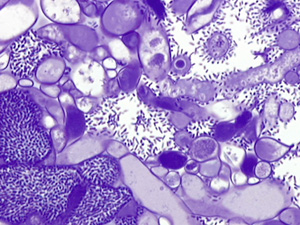 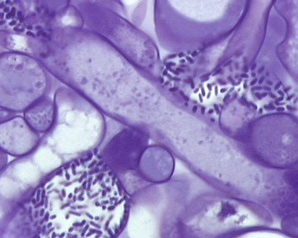
Massive,
interhyphal, bacterial growth and cell wall
degradation of tissue-forming hyphae. This infected fruit body of
Agaricus bisporus
is
disintegrating and will soon decay as a
result of bacterial invasion. Plastic embedding; 2 µm
thick section; crystal violet stain.

In this brief
account, fruit bodies of the cultivated mushroom Agaricus
bisporus played the role of the host
organism for the red pepper mite. The delicate
balance of the mushroom's growing environment was
upset by an excess of competing organisms. The mites, nematodes,
bacteria and fungi, albeit
very different organisms in
almost every aspects, depend on each other for their
existence and with this symbiosis each organism
can survive for relatively long periods.
Comments to the
author M. Halit Umar are welcomed.
Footnotes
and Web Sites
Symbiosis
means 'a living together'.
Coincidentally, this term was coined by a famous
mycologist, Heinrich Anton de Bary in 1879. In a very
broad sense, Encyclopaedia Britannica defines symbiosis as any association
between two species that live together, whether
the species benefit, harm, or have no effect on
one another.
Among nematodes,
Caenorhabditis
elegans possesses a very special place in
developmental and molecular biology. An exhaustive list of nematodes arranged by
common and scientific names also exists on the
Web.
Nematophagous fungus is in French and
explains the mechanisms of fungal nematophagy in
short.
Arthrobotrys
oligospora is in German and
diagrammatically illustrates nematophagous fungi.
The Web Site of Mushroom
Experimental Station in Horst, The
Netherlands, describes Agaricus bisporus and gives a
fair amount of information about this cultivated
mushroom. You can find there also the abstracts
of recently published papers in general and a
section about fungal morphology.
White button mushroom, Agaricus
bisporus is the link to the scientific,
oral presentation by the author during the 15th
International Congress on the Science and
Cultivation of Edible Fungi, Maastricht /The
Netherlands / 15-19 May 2000, containing
outstanding macroscopic images, plus light and
electron microscope images.
©
Microscopy UK or their contributors.
Published
in the July 2000 edition of Micscape Magazine.
Please
report any Web problems or offer general comments to
the Micscape Editor,
via the contact on current Micscape Index.
Micscape
is the on-line monthly magazine of the Microscopy UK
web
site at Microscopy-UK
|